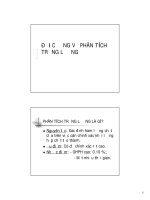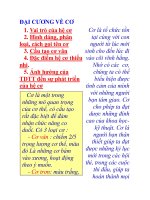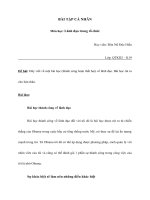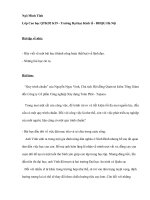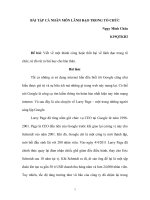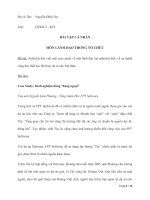Slide đại cương về lãnh đạo trong tổ chức chaptet 10 leading self managed teams
Bạn đang xem bản rút gọn của tài liệu. Xem và tải ngay bản đầy đủ của tài liệu tại đây (10.43 MB, 40 trang )
LEADERSHIP:
ng
.c
om
Theory, Application, Skill
Development
co
2d Edition
ng
th
an
Robert N. Lussier
and Christopher F. Achua
du
o
This presentation edited and enhanced by:
cu
u
George W. Crawford
Asst. Prof. of Mgmt.
Clayton College & State University
Morrow, GA 30260
9-1
Copyright ©2004 by South-Western, a division of Thomson Learning. All rights reserved.
CuuDuongThanCong.com
/>
th
an
co
ng
.c
om
Chapter 9
cu
u
du
o
ng
Leading Self-Managed
Teams
9-2
Copyright ©2004 by South-Western, a division of Thomson Learning. All rights reserved.
CuuDuongThanCong.com
/>
•
•
•
ng
co
an
th
ng
du
o
u
•
Nature of self-managed teams.
Difference between traditional & SMT.
Benefits of SMT.
Challenges of implementing SMT
effectively.
Guidelines for improving SMT
effectiveness.
4 stages of group development.
Role of team facilitator in SMT.
Distributed leadership in SMT.
cu
•
•
•
•
.c
om
Chapter 9
Learning Outcomes
9-3
Copyright ©2004 by South-Western, a division of Thomson Learning. All rights reserved.
CuuDuongThanCong.com
/>
.c
om
Self-Managed Teams;
Also Known As
cu
u
du
o
ng
th
an
co
ng
• Self-directing teams
• Self-maintaining teams
• Self-leading teams
• Self-regulated teams
9-4
Copyright ©2004 by South-Western, a division of Thomson Learning. All rights reserved.
CuuDuongThanCong.com
/>
u
du
o
ng
th
an
co
ng
Operate without managerial supervision
High job satisfaction
High commitment
Make structural and operational decisions
Responsible for tasks as a collective whole
Variety of technical skills
Versatile and flexible
cu
ã
ã
ã
ã
ã
ã
ã
.c
om
Nature of
Self-Managed Teams
9-5
Copyright â2004 by South-Western, a division of Thomson Learning. All rights reserved.
CuuDuongThanCong.com
/>
SMT
ng
Characteristics
.c
om
Differences from
Traditional Teams
Traditional
Within the team
Outside the team
Team member role
Interchangeable
Fixed
Accountability
Team
Individual
Work effort
Cohesive
Divided
Flexible
Fixed
Multiskilled
Specialized
an
th
ng
du
o
u
cu
Task design
co
Leadership
Skills
9-6
Copyright ©2004 by South-Western, a division of Thomson Learning. All rights reserved.
CuuDuongThanCong.com
/>
Self-Managed Teams
cu
u
du
o
ng
th
an
co
ng
.c
om
Relatively autonomous work groups in
which the responsibilities and obligations
traditionally maintained by management
have been transferred
to a group of people
who perform a complex
task with highly
interdependent
activities
9-7
Copyright ©2004 by South-Western, a division of Thomson Learning. All rights reserved.
CuuDuongThanCong.com
/>
Make Operating
Decisions
.c
om
SelfManaged
Teams Are
Usually
Empowered
to:
th
an
co
ng
Assign Work
Acquire Supplies
& Materials
du
o
cu
u
Create Task
Procedures
ng
Plan Schedules
Interact with
Customers
Perform
Team Member
Evaluations
Deal with
Conflicts
9-8
Copyright ©2004 by South-Western, a division of Thomson Learning. All rights reserved.
CuuDuongThanCong.com
/>
.c
om
Characteristics of
Effective Self-Managed
Teams
cu
u
du
o
ng
th
an
co
ng
• Have clear missions & high
performance standards
• Take stock of equipment, training
facilities, & other resources team
needs
• Devote significant time to planning &
organizing to use available resources
& assess members technical skills
ã High levels of communication
9-9
Copyright â2004 by South-Western, a division of Thomson Learning. All rights reserved.
CuuDuongThanCong.com
/>
Stronger Commitment
.c
om
Improved Quality
and Efficiency
th
an
Lower Turnover / Absenteeism
Faster Product Development
Flexibility Dealing with
Personnel Shortages
cu
u
du
o
ng
Potential
Benefits of
Using
Self-Managed
Team
co
ng
More Satisfied Employees
Helps Solve Problems &
Suggest Improvements
9-10
Copyright ©2004 by South-Western, a division of Thomson Learning. All rights reserved.
CuuDuongThanCong.com
/>
ng
.c
om
Norms
co
an
th
Membership
Characteristics
cu
u
du
o
ng
Organizational
Support
Team
Formation
Variables
Champion
9-11
Copyright ©2004 by South-Western, a division of Thomson Learning. All rights reserved.
CuuDuongThanCong.com
/>
.c
om
Organizational Support
cu
u
du
o
ng
th
an
co
ng
• Strong top management
support
• Commitment to allocate
adequate resources
• Compatible culture
9-12
Copyright ©2004 by South-Western, a division of Thomson Learning. All rights reserved.
CuuDuongThanCong.com
/>
.c
om
Team Member
Characteristics
cu
u
du
o
ng
th
an
co
ng
• Strong belief in personal
accountability
• Internal locus of control
• Emotional stability
ã Openness to new ideas and
different viewpoints
9-13
Copyright â2004 by South-Western, a division of Thomson Learning. All rights reserved.
CuuDuongThanCong.com
/>
.c
om
Team Member
Characteristics
cu
u
du
o
ng
th
an
co
ng
• Effective communicator
• Good problem-solving skills
• Ability to engender trust
ã Good conflict resolution skills
9-14
Copyright â2004 by South-Western, a division of Thomson Learning. All rights reserved.
CuuDuongThanCong.com
/>
.c
om
Norms
cu
u
du
o
ng
th
an
co
ng
Standards of conduct that
are shared by team
members and which guide
their behaviors
9-15
Copyright ©2004 by South-Western, a division of Thomson Learning. All rights reserved.
CuuDuongThanCong.com
/>
.c
om
Champion
cu
u
du
o
ng
th
an
co
ng
An advocate of the selfmanaged team program who
helps the program obtain
necessary resources and gain
political support from top
management and other
subunits of the organization
9-16
Copyright ©2004 by South-Western, a division of Thomson Learning. All rights reserved.
CuuDuongThanCong.com
/>
What A Champion Does
cu
u
du
o
ng
th
an
co
ng
.c
om
• Explains what self-managed teams
can do for the organization
• Communicates responsibilities,
rules, & norms to the teams
• Ensures that teams meet the goals
and needs of the organization
9-17
Copyright ©2004 by South-Western, a division of Thomson Learning. All rights reserved.
CuuDuongThanCong.com
/>
What A Champion Does
cu
u
du
o
ng
th
an
co
ng
.c
om
• Coordinates efforts of teams
• Helps teams reach decisions that
every employee can support
• Facilitates continuous learning by
team members
ã Builds & maintains trust between
teams and the organization
9-18
Copyright â2004 by South-Western, a division of Thomson Learning. All rights reserved.
CuuDuongThanCong.com
/>
.c
om
To Improve SMT
Effectiveness
cu
u
du
o
ng
th
an
co
ng
• Ensure change to supportive
culture, structure, & climate
• Have a well-thought-out vision
of SMTs
• Allow time for bonding
• Provide adequate training
ã Provide objective goals,
incentives, & infrastructure
9-19
Copyright â2004 by South-Western, a division of Thomson Learning. All rights reserved.
CuuDuongThanCong.com
/>
.c
om
To Improve SMT
Effectiveness
cu
u
du
o
ng
th
an
co
ng
• Ensure resources are adequate
• Create a sense of empowerment
• Develop team-based
measurements & feedback
• Recruit and train team
facilitators
• Do not overreact at first crisis
9-20
Copyright ©2004 by South-Western, a division of Thomson Learning. All rights reserved.
CuuDuongThanCong.com
/>
Top
Management
Support &
Commitment
.c
om
Strong &
Experienced
Facilitator
co
ng
SelfManaged
Group
Success
Factors
Unambiguous
Goals &
Objectives
Appropriate
Compensation
Structure
cu
u
du
o
ng
th
an
Appropriate
Task Design
Adequate
Information
System
Appropriate
Scope of
Authority
9-21
Copyright ©2004 by South-Western, a division of Thomson Learning. All rights reserved.
CuuDuongThanCong.com
/>
ng
.c
om
Stages
of
Group
Development
Norming
du
o
cu
u
Storming
ng
th
an
co
Forming
Performing
Adjourning
9-22
Copyright ©2004 by South-Western, a division of Thomson Learning. All rights reserved.
CuuDuongThanCong.com
/>
Less Commitment
Low Competence
Some Competence
Members come
committed but
have not developed
competence in
working together.
Members become
dissatisfied with
the team as they
develop
confidence.
th
ng
du
o
Appropriate Leadership Style
Clarify team
objectives &
roles
u
Consult
cu
Decide
Performing
Variable Commit.
High Commitment
High Competence
High Competence
ng
High Commitment
Norming
co
Storming
Commitment
changes while
competence
remains constant.
an
Forming
.c
om
Stages of Team
Development
Develop
competence
& relationships
Facilitate
Focus on
Supportive
relationships
Commitment and
competence remain
high
Delegate
Group provides
own task &
relationship
behaviors
9-23
Copyright ©2004 by South-Western, a division of Thomson Learning. All rights reserved.
CuuDuongThanCong.com
/>
cu
u
du
o
ng
th
an
co
ng
An external leader of a
self-managed team
whose job is to create a
supportive environment
where team members
take on responsibilities
to work productively and
solve complex problems
on their own
.c
om
SMT Facilitator
9-24
Copyright ©2004 by South-Western, a division of Thomson Learning. All rights reserved.
CuuDuongThanCong.com
/>
.c
om
SMT Facilitator
Team Building Activities
cu
u
du
o
ng
th
an
co
ng
• Open forums to resolve
interpersonal conflict
• Create opportunities for
social interaction
ã Increase mutual acceptance
& respect between members
9-25
Copyright â2004 by South-Western, a division of Thomson Learning. All rights reserved.
CuuDuongThanCong.com
/>
